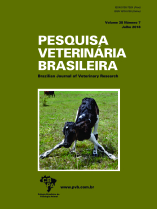 |
|
|
|
Year 2018 - Volume 38, Number 7
|

|
Neoplastic and non-neoplastic lesions of the hands and feet of dogs (2003-2016), 38(7):1394-1404
|
ABSTRACT.- Silva L.F., Blume G.R., Eloi R.S.A., Lemos J.A., Silva A.S., Lorenzo C., Sonne L., Reis Jr J.L. & Sant’Ana F.J.F. 2018. [Neoplastic and non-neoplastic lesions of the hands and feet of dogs (2003-2016).] Alterações neoplásicas e não neoplásicas das mãos e dos pés de cães (2003-2016). Pesquisa Veterinária Brasileira 38(7):1394-1404. Laboratório de Diagnóstico Patológico Veterinário, Universidade de Brasília, Brasília, DF 70636-020, Brazil. E-mail: santanafjf@yahoo.com
Hands and feet of dogs are commonly affected by neoplastic and non-neoplastic lesions. These lesions may commonly present poor clinical or histopathological prognosis and amputation tends to be the treatment of choice. Previous studies regarding the prevalence and the clinicopathological aspects of digital changes in dogs have been performed abroad, with no similar investigations in Brazil. The aim of this manuscript was to perform a histopathological study to characterize hands and feet lesions of dogs from Brazil.Tissue samples from 105 tumor‑like lesions of dogs hands and feet were used in this study. The samples came from three Brazilian veterinary diagnostic laboratories and were collected between 2003 and 2016. All specimens were fixed in 10% buffered formalin, and routinely processed for paraffin embedding and hematoxylin-eosin staining. Additionally, toluidine blue, Brown and Breen, periodic acid Schiff (PAS), Grocott Methenamine Silver (GMS) and Ziehl Neelsen were used in selected cases. Immunohistochemistry using anti-Leishmania spp., anti-CD117, anti‑CD79, anti-CD3, anti-Melan A, anti-lysozyme, anti-Pancytokeratin AE1/AE3, and anti‑vimentin antibodies were also performed. Neoplasia (62.9%) was the most frequently found lesion, followed by inflammation (19%), and other changes (18.1%). Among the neoplasms, 40.9% were mesenchymal, 39.4% epithelial, and 19.7% round cells. All round cells and most of the epithelial and mesenchymal neoplasms were malignant. There was no difference between males and females regarding neoplasia prevalence. Labrador Retriever, Schnauzer, Teckel, mongrel, German Shepherd, Rottweiler, and Pit Bull were the most frequently affected breeds. Fila Brasileiro (aka Brazilian Mastiff), Pit Bull and Schnauzer had higher incidence of mesenchymal, epithelial, and round cells neoplasms, respectively. Inflammation was more commonly observed in the Labrador Retriever and other changes were more commonly in Teckel, Labrador Retriever, and mongrel dogs. Medium age and weight were 8.4 years and 28.5 kg, respectively. Medium diameter of the tumor-like lesions was 2.5 cm and the neoplastic lesions presented higher averages. Lesions were mainly in yellow-coated dogs. Incisional biopsy samples (56.4%) and amputations (85.3%) were mostly from neoplastic cases. Right forelimb was the most affected limb, and digits were the main injured anatomic structures. Squamous cell carcinoma was the most (14.2%) commonly diagnosed neoplasm, followed by mast cell tumor (7.6%), melanoma (7.6%), and undifferentiated sarcoma (7.6%). In half of the inflammatory cases, the lesion was centered in hair follicle and surrounding dermis. The inflammatory infiltrate was predominantly piogranulomatous or lymphoplasmacytic. Follicular cyst, calcinosis circumscripta, and acrochordons were the main non neoplastic and non-inflammatory changes. |
| |
|
|
| |
|
 |